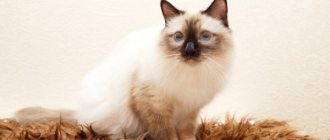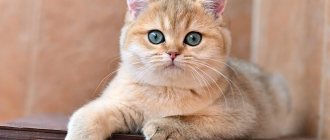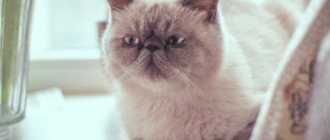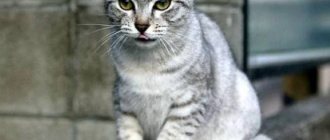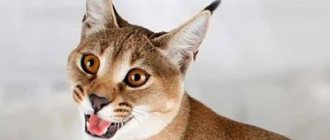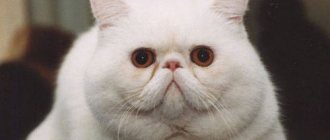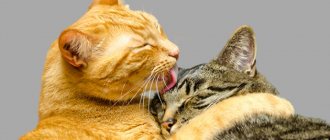The Somali cat is an amazingly beautiful creature. In 1967, Evilyn Megue, an American breeder of Abyssinian cats, took into her home a cat that had already been abandoned by about five owners within a short time. The incredible beauty of the resulting Somali breed shocked Evilin. She decided at all costs to find out at least something about his origin.
Video
* We invite you to watch a video about the Somali cat . In fact, in front of you is a playlist in which you can select and watch any of 20 videos about a given cat breed by simply clicking on the button in the upper right corner of the window. In addition, the material contains quite a lot of photos. By looking at them you can find out what a Somali cat looks like.
In this article:
|
Rate the material!
[Total votes: 4 Average: 4]
The cat family includes thousands of species. One of the most unusual breeds is the Somali cat . Somalia is often called the most "human" animal. This is a very sensitive, affectionate, playful pet. Somali cats have a bright character and beautiful appearance. They can be called an ideal companion, a friend for a person.
History of the origin of Somali cats
Somali cats did not gain recognition until 1960. They come from the Abyssinian breed, which had been known for many years before Somali recognition. For the first time, Somali kittens appeared in the United States. They began to be born from Abyssinian cats, but had an appearance that was not quite familiar to them.
Kittens appeared with long hair and were considered a waste for a long time. Most breeders first got rid of these cute kittens, even trying to find and eliminate the gene that was responsible for long hair. But all attempts to get rid of this gene were unsuccessful. This is due to its recessivity.
Interesting fact: This gene manifested itself only when a cat and a cat were present in the blood at the same time. It was transmitted, but sometimes did not show itself for years. Long-haired kittens were not noted by breeders for a long time. For this reason, it is impossible to name the exact year of the emergence of Somalia.
The reason for the appearance of the gene for long-haired cats is still considered a mystery. Some claim that with the help of long-haired cats, after the world wars they saved the population of the Abyssinian breed. Others say the cause is a mutation that arose within the breed itself. Anyway, until 1970, long-haired Abyssinian kittens were unwanted.
For the first time, Somalia was noted from a positive point of view by Evelina Magyu. She was the owner of an Abyssinian cattery. It was Evelina who made a lot of efforts to ensure that the long-haired kitten received worldwide recognition. She wanted to call the new breed "Abyssinian Longhair", but did not receive approval from the breeders. The woman had to come up with a different name. And she chose "Somali".
In 1972, Evelina created the Somali Cat Club of America. In this club, the breeder united all people interested in a new breed of cat. Thanks to Magyu’s efforts, already in 1979 the Somali cat received champion status in the CFA. A year after winning, Somalia was recognized by all major US organizations. Since that time, Somali cats have been loved by both professionals and ordinary people.
History of the breed
The Somali cat appeared as a result of the complex work of US breeders with representatives of the Abyssinian breed .
So Somalis and Abyssinians are close relatives, differing only in the length of their coat and the richness of their shades.
There are two versions of the appearance of long-haired offspring in an Abyssinian cat - this is an instant mutation and the result of crossbreeding.
Both hypotheses suggest the appearance of a “long-haired” gene in the kitten’s DNA.
Historians believe that the first distributor of this gene was breeder Janet Robertson. In the 40s of the 20th century, Janet sold her kittens all over the world.
And, presumably, long-haired kittens with very fluffy tails were born almost simultaneously from her pets in Australia, Canada and the USA.
If a Somali cat lives in an apartment, it requires regular walks. If it is not possible to let the animal outside, a well-fenced balcony is also suitable
Initially, experts considered such “Abyssinians” to be defective. Their parents were excluded from the selection process, and the babies were distributed to those who wanted them without documents.
Somali cat - description of the breed
The Somali cat is a descendant of the Abyssinian cat, so in appearance it is very similar to it.
These animals have many characteristic external features:
- Very long tail. The tail is drooping and beautiful. It is rough at the base and gradually tapers towards the tip;
- Average body size. These are relatively small animals, have a strong, “athletic” body;
- Small head, nose. These cats have a wedge-shaped head. The nose is dark in color, medium length;
- Pronounced ears. Somalis have large ears. They are placed far from each other. Wide near the base, slightly rounded at the end;
- Beautiful eyes. Somali cats have very large, expressive eyes. They are almond-shaped. Eye color may vary. There are individuals with both pure amber eyes and green ones;
- Strong limbs. These pets have long, strong, oval-shaped paws. The limbs of the animal are rather narrow;
- Long wool. The Somali has very beautiful fur. It is of medium length, has a thick undercoat, and is always shiny. Distinctive features of the breed are the presence of pants and a collar. The pet's fur is very silky and soft to the touch;
- Several coat color options. Unlike many other breeds, the Somali has a variety of coat colors. The following colors are noted: blue, wild, fawn, silver, sorel. Ticking colored cats are in great demand. This is the name of the color in which dark and light stripes on the coat alternate. Ticking cats are highly valued and cost more than others.
Standards
Males are larger in appearance than cats, and they weigh more: 4-5 kg versus 2.5-4. The chest protrudes forward, the spine bends. Height – approximately 30 cm.
| Standard | Description |
| Head | Wedge-shaped head and muzzle with smooth, smoothed features. |
| Ears | Wide at the base, medium in size, with pointed tips and tufts of hair inside. The standard also allows tassels on the tips. |
| Eyes | Large, almond-shaped, bright, rich color (yellow or green). Outlined in black. |
| Limbs | Graceful and slender, proportional to the length of the body. The paws are oval, the pads are compact, “matched”. There are 4 toes on the hind legs and 5 on the front legs. |
| Tail | Thick and very fluffy. Outwardly it resembles a fox. Tapers towards the tip. |
| Torso | Compact, muscular, with strong bones. The neck is powerful. |
| Wool | Ticked, medium in length. In the area of the panties, collar and tail it is thicker and longer. The undercoat is thick, the guard hairs are soft and thin. |
Breed defects:
- Extra fingers (or lack of fingers);
- A tail with a squiggle at the end;
- Stripes, spots, or a choker pattern on the neck;
- White spots on the head or body (exception: chin and nostrils);
- Brown hairs at the roots.
Popular colors of Somali cats
Somali cats are very graceful. These are stately animals with a flexible, toned body and a long tail. However, the main “pride” of this breed is its wool. It is lush, thick, shiny. In the Somali breed, several coat color options are allowed: blue, wild, fawn, silver, sorel. Other types of colors are considered defective.
The most popular color is wild. These cats are very expensive and are highly valued by professionals and simply by cat lovers. Wild color is a combination of bright shades: red and black or brown and red. At the same time, red and brown colors are always the main ones, and black or red colors are located only at the tips.
This color is very similar to the color of wild cats. In wild-colored cats, there are always small patches of dark-colored fur between the toes on their paws, most often black. The nose of wild-colored cats is red.
Wild color is considered natural. So is Sorel. Sorel is a copper-red color. At the same time, there are brown hairs on the tip of the tail and ears. Sorel cats have a soft pink nose and paw pads. The blue color is very unusual. In this variant, cats have a smoky blue coat color. At the same time, the animal has a red nose and gray-blue paw pads.
The fawn color is a matte cream color, while the silver color is a silver-blue shade of the coat. All of the above wool shades are officially recognized as standard. Other colors are defective!
Owner reviews about the breed
As a rule, owners of fluffy fox cats speak positively about their pets. However, you can often hear a note of fatigue in stories about the Somali cat’s mischief and desire to constantly play with any objects in the house.
Somali cats - for active and cheerful people
According to the author, cats such as Somalis are perfect for those who love to travel. After all, naturally curious fluffies love new experiences and will be happy to find themselves in an unusual environment. The main thing is to stock up on toys for the trip so that the animal does not get bored and starts to break into the interior of a car or other vehicle (especially a public one).
The cat will also enjoy short trips into nature. Somali cats will happily keep their owners company while swimming in a pond or fishing. It is only important to keep the purr on the harness at all times. After all, the innate desire to move forward can play a cruel joke on the cat. And the pet will simply run away.
The Somali cat adopted grace and aristocratic habits from its ancestors, standing out with a fluffy fur coat and a luxurious tail. Therefore, having such a purr is a pleasure.
Since the Somali is a subspecies of the Abyssinian breed, it has the same flexible and graceful body and lovely expressive face.
Cats of this breed have long hair and a fluffy collar around their neck.
The same fluffy tail is a bit reminiscent of a fox.
The cat's height is 25-30 centimeters. The weight of the animal is 3-5 kilograms.
The number of Somali colors is amazing. These are cream, chocolate, blue, lilac, “wild”.
But in all shades there is always ticking - dark transverse stripes separating several shades of color on each hair.
Character and habits of Somali cats
Most felines are not very active. Domestic cats are lazy and can lie on the couch all day long. If you are looking for just such a cat, then the Somali breed is not for you.
Somali cats are always very active. They are friendly and playful. Their playfulness does not disappear even with age. All day long these pets jump, play, and constantly move around the house. For such animals, special toys are extremely necessary. If they are not there, the cat will gradually begin to carry the personal belongings of its owners.
Somali cats are unique. They are not at all afraid of water and love to play with it. Sometimes these animals specifically sit down near the water tap, try to catch it with their paws, and observe. Most people also note “humanity” in these animals. They assure that the Somali cat can become not just a pet, but a real little member of the family. The animal has an easy-going character, a high level of intelligence, and is distinguished by its intelligence.
Another feature of this breed is silence. Somali cats do not yell without reason. They can make themselves known by screaming only when they are hungry. Due to the high activity level of these animals, food bowls should always be full. Somalia is also distinguished by perseverance and courage. They are not inferior to either animals or people if something gets into their head. In such a situation, it is easier to give in than to constantly fight. Sociability is another character trait inherent in this breed. Somalis love to be in the company of people. This is a true comrade, a friend of his owner.
Interesting facts about Somali cats
Somali cats combine external beauty and high intelligence. They are often called domestic foxes due to their external resemblance to this wild animal. These pets are unique.
You can find the most interesting facts about them below:
- Cats of the Somali breed are more reminiscent of dogs in their character and habits. With proper attention, they can be taught even simple tricks. They can carry out various commands, come when called;
- These pets almost always purr and do not annoy others with a loud voice. Sometimes cats purr even just by looking at their owner;
- Some diseases in this animal can be caused by loneliness. Somalia is constantly in need of attention. People who spend all day at work should not have such a pet. If you often have to leave your pet alone, then you should definitely buy him a friend - a second Somali cat;
- Somalia is very sensitive to cold and drafts. Despite their thick, long fur, these animals can easily be seen through;
- The most common reason for Somali owners to visit a veterinarian is injury to the limbs. These animals suffer from their excessive activity. Limbs are injured as a result of jumping;
- Somali cats have a slender, toned body. However, few people know that they are very prone to obesity. This animal should not be overfed. His owners must strictly control the amount of food he eats. If your cat is rapidly gaining weight, you should immediately consult a doctor. He will prescribe a special diet. Obesity is dangerous due to its harmful effects on internal organs.
Castration and sterilization
Castration and neutering is the procedure of removing an animal's gonads. Some people refuse the procedure because they consider it inhumane. Some owners think that after surgery the animal will gain weight and become passive. But if you are not going to breed pets, then this procedure has a place.
The operation itself lasts, on average, 15-20 minutes, but caring for the animal after the procedure requires due attention. The first day when a cat recovers from anesthesia, they either wake up or fall asleep again. Feeding is not required in the first hours, but drinking should be plentiful. It is also worth protecting your pet from excessive activity for at least the first week after surgery.
Pros and cons of Somali cats
Somali cats are the closest relatives of the Abyssinian breed. They took the best qualities from her. Somalis are distinguished by their luxurious wool. They are often compared to small fluffy foxes, and some experts note their great resemblance to squirrels. This cat breed, like any other, has its pros and cons. It is worth familiarizing yourself with them in more detail if you are planning to get yourself such a pet.
Among the advantages of the breed it is worth noting the following:
- Excellent learning ability. Cats are very similar in intelligence to dogs. They are easy to teach simple commands. Cat owners note their incredibly intelligent look, responsiveness, and friendliness;
- Almost complete absence of shedding. The Somali sheds minimally. The cat retains its fur all year round and has a stunning appearance. Owners of such cats will not have to constantly clean carpets, upholstered furniture, and their own clothes;
- Good health. In general, these animals are in excellent health. They rarely get sick and are not susceptible to genetic diseases;
- High activity, cheerfulness. You will never get bored with this pet. He will constantly jump, play, and have fun.
There are not many disadvantages of the Somali cat breed. The main disadvantage is the animal’s indifference to hair. These cats will constantly touch the hair with their paws and play with it. Those with long hair will definitely not like this. Another significant disadvantage is the intolerance of loneliness. These animals constantly require attention and toys.
Breeding Somali cats
Somali cats are in great demand on the market. They are expensive, so many Somali lovers are thinking about breeding them. Somali cats mature early. The first signs of estrus can appear as early as four months. However, it is absolutely forbidden to mix a cat at this age with a cat. The Somalia will have to wait at least another six months for breeding. One year is the best time for mating. During this time, the cat should go through two or three heats.
Important fact: You should choose a good stud cat for mating. You need to pay attention to its appearance, the condition of its coat and teeth. You also need to check the availability of all necessary vaccinations and test results. The mating itself should be carried out on the territory of the male.
This will solve two problems at once: the cat will become much more confident in its abilities, and the cat will not have to defend its territory. One of the animal owners may be present during mating. Many people in the room will distract from the process.
After a successful mating, the pregnancy period will begin. It lasts about sixty-five days. A Somali cat usually gives birth to up to four kittens. However, it happened that six kittens were born at once. This is a record number so far. Kittens are born very bright and retain their color into adulthood.
Babies must live with their mother until they are twelve weeks old. Up to three months, the kittens will develop their character and socialization will occur. Newborn babies, like adults, are very active. They need to be constantly supervised or placed in a special playpen.
How to choose a Somali kitten
It is necessary to purchase a kitten no earlier than three months after birth. Until this time, it is better for him to stay close to his mother on natural feeding. This way he will get the maximum benefit from the cat’s milk and instill the necessary social skills for living next to a person.
When choosing a kitten, it is important to pay special attention to its reaction. The kitten should not be too timid or, conversely, aggressive. An animal must make contact with a person, even if it sees him for the first time in its life. There are a number of aspects to pay attention to:
- Full color formation occurs only at the age of two years. Kittens have a two-color color - light on the sides, darker hair on the legs.
- The kitten should be playful and curious. Kids are always active, very active (sometimes even too active).
- Clean healthy mucous membranes, ears and eyes without serous discharge.
- The wool shimmers with a characteristic shine. This indirectly indicates good health. Any problems affect the quality of the coat. In a healthy individual it is always beautiful and rich.
The Somali cat breed is not cheap. Such a pet is expensive and its maintenance requires a lot of expenses. A pet class cat can cost from twenty-five thousand rubles. Breeding and show kittens cost from fifty thousand rubles.
How to distinguish a real Somali cat
The Somali cat breed is the fruit of the work of US breeders, and its direct ancestor is the Abyssinian. The difference between these two breeds is the length of the hairs, fluffiness and variety of colors.
How much does a Somali kitten cost?
How much a Somali kitten costs depends on its belonging to a particular class, pedigree, and appearance. The average price for kittens is about 25,000 rubles. An adult can cost from 40,000 to 100,000 rubles, with females being more expensive than males.
This cost is due to the rarity of the breed and the shortage of nurseries and official breeders. Finding a purebred kitten with an ideal appearance is not an easy task. Many of those who decide to get this breed import kittens from the USA or the EU, since in Russia there is a high risk of acquiring non-purebred individuals.
In all CIS countries, Somalis are a rarity. Often other breeds are passed off as them, for example, the same Abyssinians. If a person does not know how they differ, it is easy to make a mistake and buy an individual with an admixture. It is imperative to buy kittens from trusted nurseries, of which there are very few in our country.
Useful reading: interesting facts about cats.
Caring for Somali cats
Somali cats have beautiful thick, long hair. This is what scares most people, because it seems that such a fluffy pet will have to be constantly looked after. However, this is a misconception. Despite the length of the coat, the Somali “fur coat” does not require complex care.
All you need to do is comb the animal several times a week with a special comb. The comb can be purchased at any pet store. Most cats love brushing, so it won't cause any inconvenience to anyone.
Regular domestic cats can only be brushed. This will be quite enough to maintain the neat appearance of the animal. If the pet participates in various competitions and shows, then the Somali will also have to be bathed.
Typically, cats of this breed can easily tolerate bathing. Many pets even love water treatments, but for this, the kitten should be taught to take a bath from a very early age. You need to bathe your cat in warm water using special care products.
Somali owners must ensure the cleanliness of the animal’s ears and teeth. Once every six months you can take your pet for professional teeth cleaning. Then he will never have problems with his teeth. Nails can be trimmed with special scissors or this procedure can be done by a groomer. However, trimming the claws is not necessary. You can train your pet to use a special scratching post. Also, we must not forget about the proper nutrition of the Somali cat. These are active animals that need complex nutrition and vitamins.
Catering
A balanced and healthy diet is the key to your pet’s well-being and beautiful appearance. Somali cats get used equally well to both industrial food and natural food, but choose one: mixing one with the other, the animal will develop intestinal upset.
Recommended food
Ready-made food saves a lot of time, not forcing you to regularly stand at the stove. But you need to know how to choose it! Don't believe loud advertisements and bright wrappers on TV screens: read the labels on the packages. Good food does not use meat waste, dyes, artificial preservatives, flavor enhancers, etc. Economy and premium food: PreVital, Sheba, Whiskas.
But the food from the holistic and super-premium groups is much better in quality. They cost, of course, significantly more, but take a look at the composition! A good vitamin and mineral supplement, dried vegetables, berries and fruits, natural preservatives (tocopherols), rice, lentils and potatoes as sources of carbohydrates, dehydrated and fresh fish fillets and meat - all this saturates the pet and is beneficial for the pet.
Holistic foods recommended by experienced breeders: Applaws, Go Natural, Grandorf. Super premium ones include: Brooksfield, Duke's Farm, Fitmin For Life.
Below are the recommended holistic and super-premium foods. Links with the names of the food are clickable, on them you can, within our website, read the descriptions of the food and read reviews from owners of Somali cats.
| Holistic | Super premium | Super premium |
| Acana | Dr Clauder's | Brit Care |
Natural products
Not everything is simple with natural food either. Your food - soups, purees, cutlets, fried wings - is absolutely not suitable for a cat. Therefore, you will have to cook for her separately.
The correct menu consists of the following products:
- Porridges boiled in water: rice, buckwheat, millet, oatmeal, lentil. You need to add finely chopped vegetables to the porridge: pumpkin, beets, zucchini, carrots. Pour in half a teaspoon of oil (olive, sunflower or flaxseed), add some herbs (dill, parsley or green salad and crumble the boiled chicken yolk). Your pet will eat this porridge with pleasure.
- Meat is the main part of the diet. It should be given every day, defrosted and doused with boiling water (to destroy parasite larvae). Veal, rabbit, turkey, beef, lamb - whatever you have enough money for. Pamper your cat with offal a couple of times a week. These are chicken necks (ground into minced meat), chicken gizzards and hearts, and cartilage. Kittens are usually started feeding baby meat food.
- You can give fish, but rarely: no more than once a week. And only sea fish: trout, hake, flounder, salmon. Boiled squid and finely chopped shrimp can also be included in the diet.
- Among dairy products, cats are very fond of low-fat cottage cheese, yogurt, sour cream, natural yoghurts, and hard cheeses.
- Treats for cats: not cookies or candies, but cucumbers, melons, apples, pears. Green grass (sprouted wheat and oats) is also not a whim, but a necessity. With its help, the cat gets rid of hairballs that have entered the stomach.
You cannot give:
- Fatty or rotten meat, lard, pieces of fat, tripe, bones (even boiled);
- Sausages, sausages, smoked meats, canned food for people;
- River fish, fish with small bones;
- Pea and chickpea porridge, white cabbage, avocado, grapes, bananas, eggplants, potatoes, tomatoes, onions, garlic, citrus fruits;
- Human drinks: juices, mineral and sparkling water, coffee, tea, cocoa;
- Spices and seasonings, salt, sugar;
- Baked goods, flour, spicy, flour, sweet, salty, dried, pickled.
Be careful with whole cow's milk. If the cat has been accustomed to it since childhood and has no problems with the stomach or “stool”, then there is nothing to worry about. Otherwise, avoid milk.
An adult cat is fed no more than 2 times a day: morning and evening. An exception is made for pregnant cats, as well as seriously ill animals. Kittens up to six months are fed 3-6 times; the younger the baby, the more often they eat.
Somalis are water-drinkers, so fresh and clean water should always be poured into their bowl. If her cat sees even a speck of dust on the surface, she will not drink, but will crawl to the tap or even into the toilet. Water can be bought in a store, purified through a filter, or left in an open pan for 10-12 hours.
Diet of Somali cats
An important component of caring for Somali cats is the correct diet. The diet should be based on the behavioral characteristics of the animal. Most Somalis are very mobile and active. For this reason, protein should predominate in the daily menu of this animal. Achieving a perfectly balanced diet using natural foods is very difficult. Therefore, most owners choose ready-made food.
Premium and extra class food is suitable for Somali cats. Such ready-made food is not cheap, but it will provide your pet with a set of all the necessary elements and vitamins. In addition, the food is very convenient to use. If you have decided to give natural food, then you should definitely purchase vitamins in addition to it. Vitamin complexes with phosphorus and calcium are suitable.
From natural food, a Somali cat should be given:
- Cottage cheese, fermented baked milk and other fermented milk products;
- Offal, cooked meat;
- Boiled fish;
- Quail, chicken eggs;
- Boiled vegetables.
You need to feed your cat twice a day. Any snacks or treats from the table must be strictly prohibited. Somali cats have an excellent appetite and will eat almost anything. Uncontrolled feeding can lead to rapid obesity of the animal and serious health problems.
You can also introduce special cat grass into your furry’s diet. Animals really like cat grass and have a beneficial effect on the digestive system. It will help cleanse the stomach and intestines of swallowed hairballs.
Diseases and health problems
Somali cats are one of the strongest felines. They are practically not susceptible to genetic diseases and have excellent immunity. However, there is no guarantee that your pet will live his entire life without ever getting sick.
To preserve the health of an animal as much as possible, a person also needs to make certain efforts. You should ensure a balanced diet, vaccinate your animal on time, and be sure to visit a veterinarian for preventative purposes. The schedule for visiting a doctor should be made individually.
The weakest point of Somalia is the teeth and gums. The most common disease is gingivitis. This is inflammation of the gums, which in its advanced form can lead to tooth loss. To prevent this from happening, the kitten should brush its teeth weekly and have a professional cleaning every six months. Also, the prevention of this disease is the introduction of solid food into the diet. Solid food will help keep your pet's oral health healthy.
Autoimmune anemia is another common disease among Somali cats. However, it is highly treatable if diagnosed early. To detect anemia, you need to take periodic blood tests.
As noted above, Somali cats are practically not susceptible to genetic diseases. But there have been cases of renal amyloidosis. Identifying a genetic disease is extremely difficult. To ensure that the chosen kitten is healthy, you need to be one hundred percent confident in the reputation of the breeder.
Health
In general, the Somali cat is distinguished by good health and strong immunity. However, there are a number of hereditary diseases that are typical for representatives of the breed.
Retinal atrophy. The first signs of the disease begin to appear at six months of age. Only timely diagnosis can save your pet’s vision. If the disease is neglected, it will lead to complete blindness.
Amyloidosis of the kidneys. Passed on by inheritance. It is a disorder of protein metabolism. Females are at increased risk. It can be stopped, but not cured.
Gingivitis. Looks like gum inflammation. To prevent disease, the animal's teeth are regularly brushed.
Hemolytic anemia. The disease is not cured, but compensatory therapy is carried out.
Obesity is a non-hereditary disease in cats. Of course, it’s their own fault that they love to eat treats. But the regime and diet, after all, are on the conscience of the owners.
The key to purchasing a healthy Somali pet is a thorough study of its pedigree. Good heredity, timely vaccination and caring attitude from breeders guarantee a long and happy life for the Somali. Cats live on average thirteen to fifteen years.
